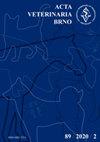猫在不同环境下的血支原体感染
IF 0.7
4区 农林科学
Q3 VETERINARY SCIENCES
引用次数: 1
摘要
嗜血微生物是感染红细胞的最常见细菌,与不同严重程度的贫血有关。本研究的目的是关注猫血支原体、微小血支原体和尿支原体在猫中的发生情况。我们跟踪了受感染个体的繁殖条件、年龄、性别、基本血液学指标以及与一种猫科逆转录病毒的共同感染。共调查了73只猫。用聚合酶链式反应(PCR)检测血浆瘤,并通过测序进行验证。血液学检查的重点是红细胞数量、血红蛋白浓度和红细胞压积。通过快速免疫色谱法检测逆转录病毒,检测了40份猫血样本的子集。在我们的研究组中发现了以下情况:12.3%的个体中出现了血毛滴虫,35.6%的个体中发现了血毛线虫,17.8%的个体出现了尿毛滴虫。仅在家中生活的猫(15%)和有户外活动的猫(69.8%)的血支原体阳性证据之间存在高度显著差异。与1-3岁和1岁以下的猫相比,3岁以上猫的支原体发病率也存在高度显著的差异。男女之间的感染频率没有差异。我们组的血液支原体感染没有伴随血液学指标的根本性变化,只有三例病例的血红蛋白值下降。在一组猫中,也检查了是否存在逆转录病毒感染,在所有五例阳性病例中都证实了血液中的支原体感染。本文章由计算机程序翻译,如有差异,请以英文原文为准。
Infections of cats with blood mycoplasmas in various contexts
Haemotropic microorganisms are the most common bacteria that infect erythrocytes and are associated with anaemia of varying severity. The aim of this study was to focus on the occurrence of Mycoplasma haemofelis, Mycoplasma haemominutum, and Mycoplasma turicensis in cats. We followed infected individuals’ breeding conditions, age, sex, basic haematological indices, and co-infection with one of the feline retroviruses. A total of 73 cats were investigated. Haemoplasmas were detected by PCR and verified by sequencing. Haematology examination was performed focusing on the number of erythrocytes, haemoglobin concentrations and haematocrit. A subset of 40 cat blood samples was examined by a rapid immunochromatography test to detect retroviruses. The following was found in our study group: M. haemofelis in 12.3% of individuals, M. haemominutum in 35.6% of individuals and M. turicensis in 17.8% of individuals. A highly significant difference was found between positive evidence of blood mycoplasmas in cats living only at home (15%) and in cats with access to the outside (69.8%). There was also a highly significant difference in the incidence of mycoplasma in cats over 3 years of age compared to 1–3 years of age and up to 1 year of age. There was no difference in the frequency of infections between the sexes. Blood mycoplasma infection in our group was not accompanied by fundamental changes in the haematological indices and was only reflected by a decrease in haemoglobin values in three cases. In a subset of cats that were also examined for the presence of retroviral infection, mycoplasma infection in blood was confirmed in all five positive cases.
求助全文
通过发布文献求助,成功后即可免费获取论文全文。
去求助
来源期刊

Acta Veterinaria Brno
农林科学-兽医学
CiteScore
1.00
自引率
33.30%
发文量
36
审稿时长
18-36 weeks
期刊介绍:
ACTA VETERINARIA BRNO is a scientific journal of the University of Veterinary and Pharmaceutical Sciences in Brno, Czech Republic.
The scientific journal Acta Veterinaria Brno is dedicated to the publication of original research findings and clinical observations in veterinary and biomedical sciences. Original scientific research articles reporting new and substantial contribution to veterinary science and original methods that have not been submitted for publication elsewhere are considered for publication. A written statement to this effect should accompany the manuscript, along with approval for publication by the author´s head of department. The authors bear full responsibility for the contents of their contribution. Book reviews are published, too.
 求助内容:
求助内容: 应助结果提醒方式:
应助结果提醒方式:


